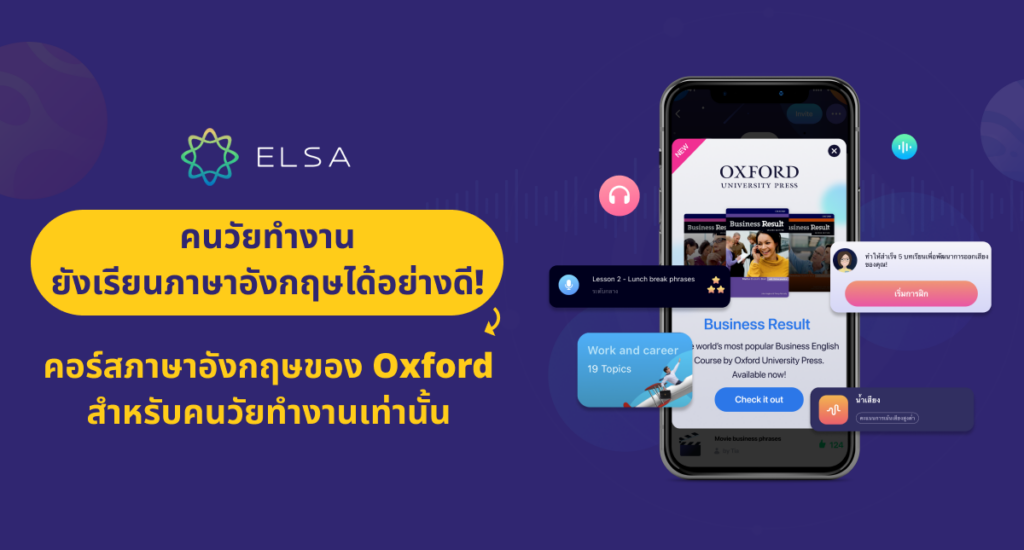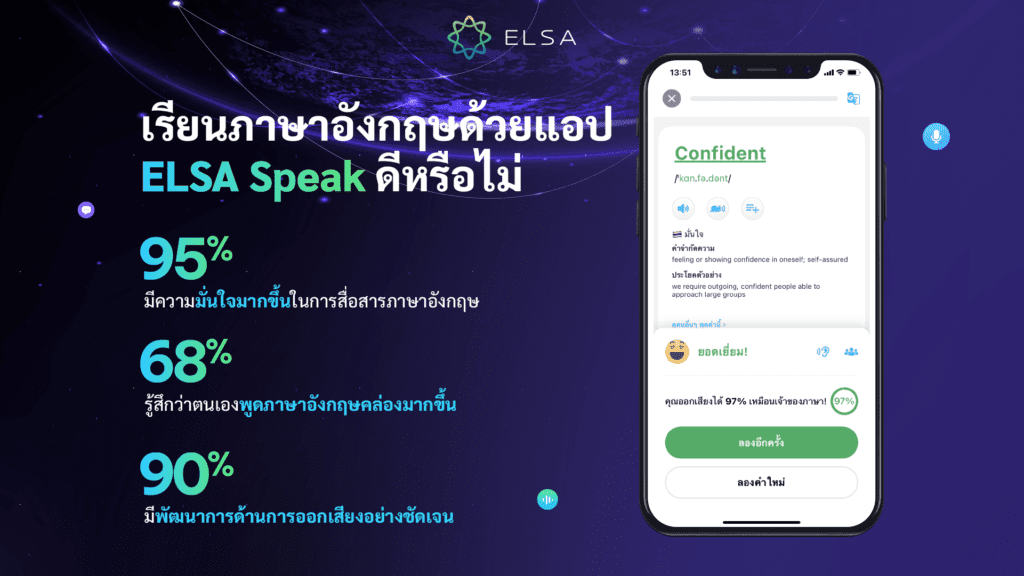Future Continuous Tense เป็นหนึ่งใน tense พื้นฐานในภาษาอังกฤษ ในบทความนี้ มาร่วมกับ ELSA Speak เรียนรู้เกี่ยวกับหลักการใช้งาน และการประยุกต์ใช้ Future Continuous Tense ในสถานการณ์ต่างๆ ตั้งแต่การแสดงการกระทำในอนาคตที่วางแผนไว้ จนถึงการแสดงความต่อเนื่องของการกระทำในเวลาที่กำหนดในอนาคต มาลองดูวิธีการใช้ Future Continuous Tense ในบทความด้านล่างนี้กันนะ!
Future Continuous Tense คืออะไร
เป็น tense ที่มีหน้าที่หลักคือ แสดงการกระทำที่กำลังดำเนินอยู่ในช่วงเวลาหนึ่งในอนาคต
สอบก่อนเข้าฟรี

ตัวอย่าง
This time next month, I will be studying in London.
(เวลานี้เดือนหน้า ฉันจะกำลังเรียนที่ลอนดอน)
Tomorrow, our daughter will be competing in a basketball match at 10am.
(พรุ่งนี้ ลูกสาวพวกเราจะกำลังแข่งบาสตอนสิบโมงเช้า)
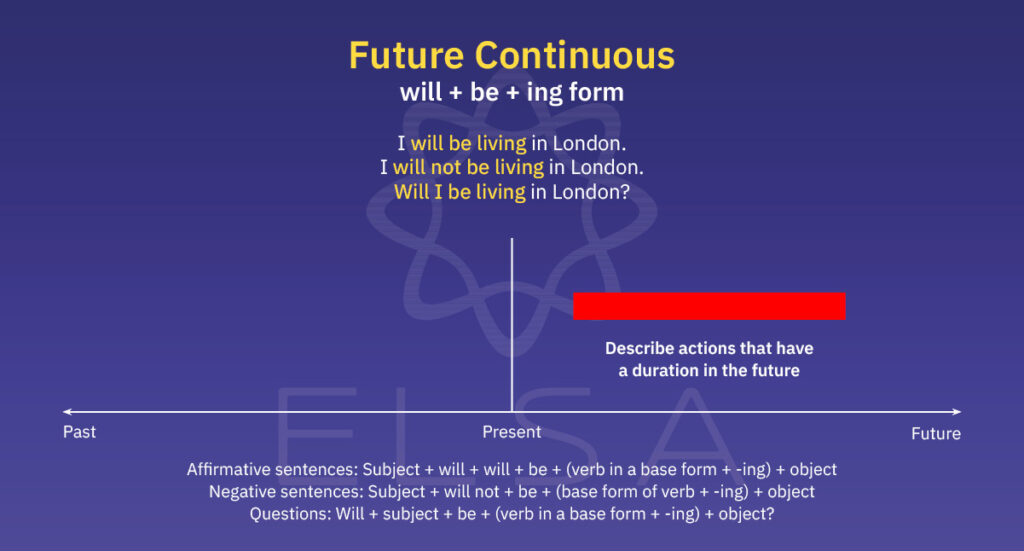
โครงสร้าง Future Continuous Tense
รูปแบบประโยคบอกเล่า
- S + will + be + V-ing + O
รูปแบบประโยคปฏิเสธ
- S + will not + be + V-ing + O
รูปแบบประโยคคำถาม
- Will + S + be + V-ing + …?
- Wh-question + will + S + be + V-ing
S + will + be + V-ing + O
หมายเหตุ: will= ‘ll
ตัวอย่าง
At 10 am tomorrow, our daughter will be performing on stage.
(วันพรุ่งนี้ในเวลาสิบโมงเช้า ลูกสาวของพวกเราจะกำลังแสดงบนเวที)
Julia and Mary will be traveling in Bali this time next month.
(จูเลียและแมรี่จะกำลังเดินทางในบาหลีในเดือนหน้านี้)
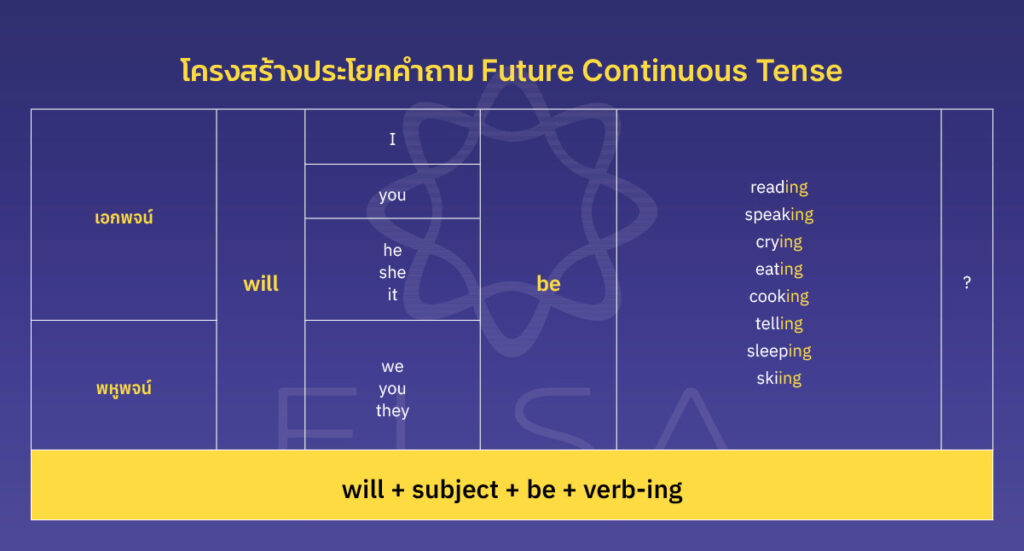

รูปแบบประโยคปฏิเสธ
S + will not + be + V-ing + O
หมายเหตุ: will not = won’t
ตัวอย่าง
Laura has delayed going to Korea to study, so she won’t be studying there at the end of this year.
(ลอร่าเลื่อนการไปเรียนต่อที่เกาหลี ดังนั้นเธอจะไม่เรียนที่นั่นในสิ้นปีนี้)
I think they won’t be cooking when we get there. We have agreed to eat out.
(ฉันคิดว่าพวกเขาจะไม่ทำอาหารเมื่อเราไปถึงที่นั่น เราตกลงกันว่าจะทานอาหารนอกบ้าน)

รูปแบบประโยคคำถาม
A. คำถาม Yes – No
Will + S + be + V-ing + …?
Yes, S + will.
No, S + won’t.
ตัวอย่าง
Will our team be playing when we get there?
(ทีมของเราจะกำลังเล่นเมื่อเราไปถึงที่นั่นใช่ไหม?)
Yes, they will. I think so.
(ใช่ คงกำลังเล่นนะ ฉันคิดแบบนั้น)
Will Tan be living with you this time in July?
(กรกฎาคมนี้ ตาลจะกำลังอยู่กับคุณใช่ไหม?)
No, she won’t. She has canceled the plan.
(ไม่นะ เธอจะไม่อยู่ เธอยกเลิกแผนไปแล้ว)
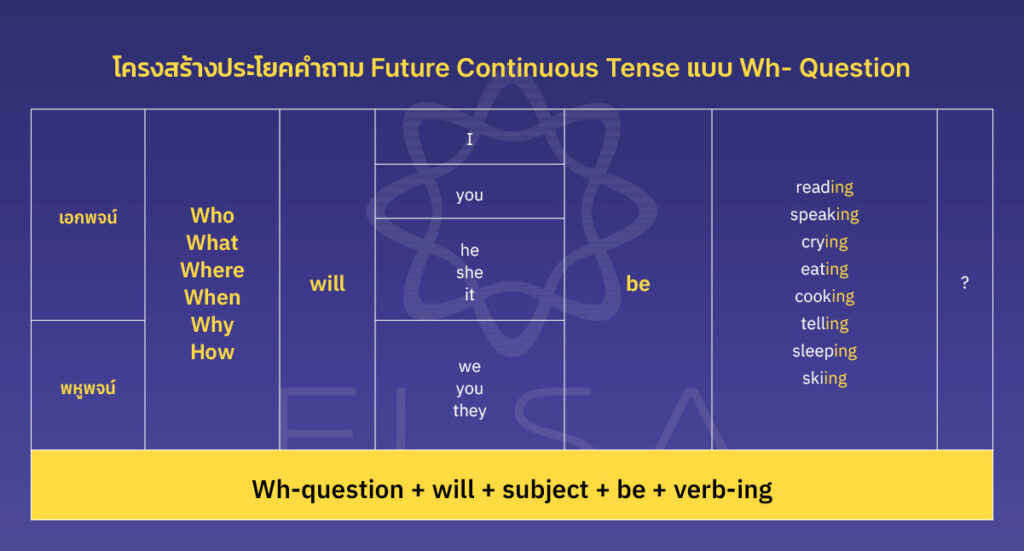
B. คำถาม Wh-
คำใช้ถามไม่ใช่หัวเรื่อง
What/ Where/ When/ Why/ How/ Who(m) + will + (not) + S + be + V-ing + …?
ตัวอย่าง
What will they be discussing when we get to the meeting?
(พวกเขาจะกำลังคุยอะไรกันเมื่อเราไปถึงที่ประชุม?)
Who(m) will our mom be talking to when we get home?
(แม่ของเราจะกำลังคุยกับใครเมื่อเรากลับถึงบ้าน?)
Which movie will Peter be watching at 7:30 this evening?
(ปีเตอร์จะกำลังดูหนังเรื่องไหนตอน 7:30 น. เย็นนี้?)
คำใช้ถามคือหัวเรื่อง
What/ Who + will (not) + be + V-ing + …?
ตัวอย่าง
What will be happening when we arrive at the party?
(มีอะไรจะกำลังเกิดขึ้นเมื่อเราไปถึงงานปาร์ตี้?)
Who will be performing at 8 tomorrow evening?
(ใครจะกำลังขึ้นแสดงตอนสองทุ่มวันพรุ่งนี้?)

หลักการเติม -ing ใน Future Continuous Tense
หลักการทั่วไป
ถ้าคำกริยาที่จะผันไม่ได้อยู่ในสถานการณ์ด้านล่างนี้ ให้เติม -ing ต่อกริยาตามปกติ
ตัวอย่าง กริยาเติม ing
cook → cooking
sing → singing
perform → performing
repeat → repeating
>>> Read more: กริยาไม่ปกติ (Irregular Verbs) ในภาษาอังกฤษที่ครบถ้วนที่สุด
คำกริยาที่ลงท้ายด้วย “e”
เมื่อคำกริยาที่จะผันลงท้ายด้วย “e” เราต้องทิ้ง “e” แล้วเติม -ing
ตัวอย่าง
- They are racing. (พวกเขากำลังแข่ง)
(race → racing)
- Look! She’s waving at us. (ดูสิ! เธอกำลังโบกมือให้พวกเรา)
(wave → waving)

คำกริยาที่ลงท้ายด้วย “ie”
ในกรณีนี้ เราต้องเปลี่ยน “ie” เป็น “y” แล้วเติม -ing
ตัวอย่าง
- Her cat is lying in my bed. (แมวของเธอกำลังนอนอยู่บนเตียงของฉัน)
(lie → lying)
- There’s too much to do. I’m dying. (มีมากเกินไปที่จะทำ ฉันกำลังจะตาย)
(die → dying)
คำกริยาที่มี 1 พยางค์ ลงท้ายด้วยพยัญชนะ นำหน้าด้วยสระ
ในกรณีนี้ เราเพิ่มพยัญชนะตัวสุดท้ายเป็นสองเท่า แล้วเติม -ing
ตัวอย่าง
- The hairdresser is cutting my hair. (ช่างตัดผมกำลังตัดผม)
(cut → cutting)
- They are putting fruits into the fridge. (พวกเขากำลังใส่ผลไม้เข้าไปในตู้เย็น)
(put → putting)
คำกริยาที่มี 2 พยางค์ ลงท้ายด้วยพยัญชนะ นำหน้าด้วยสระ เน้นเสียงอยู่ที่พยางค์ที่ 2
ในกรณีนี้ เรายังเพิ่มพยัญชนะตัวสุดท้ายเป็นสองเท่า แล้วเติม -ing
ตัวอย่าง
- Leaves are beginning to fall. (ใบไม้กำลังเริ่มร่วงหล่น)
(begin→ beginning; /bɪˈɡɪn/)
บางกรณีที่พิเศษ
- travel → travelling (อังกฤษ – อังกฤษ) หรือ traveling (อังกฤษ – อเมริกัน)
- kidnap → kidnapping (อังกฤษ – อังกฤษ) หรือ kidnapping (อังกฤษ – อเมริกัน)
หลักการใช้ Future Continuous Tense
แสดงการกระทำที่กำลังดำเนินการในช่วงเวลาหนึ่งในอนาคต
Our kids will be playing at the waterpark this time tomorrow.
(ลูกๆ ของเราจะกำลังเล่นที่สวนน้ำในเวลานี้ในวันพรุ่งนี้)
As they have canceled the trip, they won’t be relaxing on that island next weekend.
(เนื่องจากพวกเขายกเลิกการเดินทางไปแล้ว พวกเขาจะไม่พักผ่อนบนเกาะแห่งนั้นในสุดสัปดาห์หน้า)
แสดงการกระทำที่จะกำลังดำเนินการ (ในช่วงเวลาหนึ่ง) ในอนาคต แล้วมีการกระทำอื่นเกิดขึ้นหรือขัดจังหวะ
I think they will be cooking dinner when the kids get to their place.
(ฉันคิดว่าพวกเขาจะกำลังทำอาหารเย็นเมื่อเด็กไปถึงที่ของพวกเขา)
Trust me! They won’t be talking about that problem when we enter the meeting. They already discussed it yesterday.
(เชื่อฉันเถอะ! พวกเขาจะไม่พูดถึงปัญหานั้นเมื่อเราเข้าประชุม พวกเขาคุยกันแล้วเมื่อวานนี้)

แสดงการกระทำหลายอย่างที่กำลังเกิดขึ้นพร้อมๆกัน ในช่วงเวลาหนึ่งในอนาคต
หมายเหตุ: ใน Continuous Tense อื่นๆ คือ Present Continuous Tense และ Past Continuous Tense คำสันธานระหว่างสองอนุประโยค (ต่างใช้ Future Continuous Tense) จะเป็น “while” แต่ว่าเราไม่สามารถใช้ Future Tense (รวมถึง Future Continuous Tense) ในอนุประโยคที่ขึ้นต้นด้วยคำสันธานบอกเวลา เช่น ‘ while’, ‘when’ เป็นต้น ดังนั้นในกรณีนี้ เราจะใช้คำเชื่อม ‘and’ เพื่อเชื่อมอนุประโยคทั้งสอง
This time next Friday, we will be working, and he will be resting at home.
(เวลานี้วันศุกร์หน้า พวกเขาจะกำลังทำงานและเขาคงกำลังพักผ่อนที่บ้าน)
Alan will be studying at school, and Jerry will be hanging out with friends at 10:15 tomorrow morning.
(อลันจะกำลังเรียนอยู่ที่โรงเรียน ส่วนเจอร์รี่จะกำลังออกไปเที่ยวกับเพื่อนๆ ในพรุ่งนี้เช้าในเวลา 10.15 น.)
รวมกับ ‘‘still’ เพื่อแสดงการกระทำที่เกิดขึ้นในขณะที่พูดและมีแนวโน้มที่จะกำลังดำเนินต่อไปในอนาคต
I think when our boss gets here, we will still be typing this report. It’s so long.
(ฉันคิดว่าเมื่อหัวหน้ามาถึงที่นี่ เราจะยังคงกำลังพิมพ์รายงานนี้อยู่ มันยาวมาก)
I guess at 10, the children will still be watching TV.
(ฉันเดาว่าตอน 10 โมง เด็กๆ จะยังคงกำลังดูทีวีอยู่)
เน้นหรือถามถึงแผนและความตั้งใจในอนาคต
We will be flying to Japan this Summer.
(เราจะบินไปญี่ปุ่นในฤดูร้อนนี้)
Will you be attending the meeting tomorrow?
(คุณจะเข้าร่วมการประชุมในวันพรุ่งนี้หรือไม่)
สร้างบรรยากาศเมื่อจินตนาการ/ทำนายอนาคต โดยปกติจะมีการกระทำมากกว่า 1 การใน Future Continuous Tense
When she gets to the restaurant, he will be waiting for her, the music will be playing and the server will be preparing the champagne.
(เมื่อเธอไปถึงร้านอาหาร เขาจะกำลังรอเธออยู่ เพลงจะกำลังเล่น และเซิร์ฟเวอร์จะกำลังเตรียมแชมเปญ)
Everyone will be cheering and waving their hands when the singer appears on the stage.
(ทุกคนจะกำลังส่งเสียงเชียร์และโบกมือเมื่อนักร้องปรากฏตัวบนเวที)
เข้าใจและใช้ Present Tense Future Tense ได้อย่างถูกต้องและมั่นใจ
Present Perfect Continuous Tense โครงสร้าง ตัวอย่าง และแบบฝึกหัดพร้อมคำตอบ
สัญญาณการรับรู้ Future Continuous Tense
มีปัจจัยอย่างหนึ่งด้านล่างนี้
- when + อนุประโยค (clause) ก็ใช้ Present Simple Tense
- (at) this time/ moment + ช่วงเวลาหนึ่งในอนาคต: (at) this time tomorrow, (at) this moment next weekend,…
- at + ชั่วโมงที่เฉพาะ + ช่วงเวลาหนึ่งในอนาคต: at 7pm tomorrow, at 9:15 tomorrow morning,…
หมายเหตุบางอย่างของ Future Continuous Tense
สำหรับอนุประโยคที่ขึ้นต้นด้วย when, while, before, after, by the time, as soon as, if, if, less…
เราจะไม่ใช้ Future Tense ในอนุประโยคที่ขึ้นต้นด้วยคำสันธานบอกเวลาข้างต้น เนื่องจากมีหลักการว่า Future Tense จะไม่ใช้ในอนุประโยคบอกเวลา
ในขณะเดียวกันก็มีสาเหตุแยกจากกันสำหรับแต่ละคำสันธาน (กลุ่มคำสันธาน) ดังต่อไปนี้:
- before, after, by the time, as soon as, if, unless: การใช้ Future Continuous Tense ในอนุประโยคจะไม่สร้างตรรกะ สมเหตุสมผลในความหมาย โดยเฉพาะอย่างยิ่งในแง่ของความสัมพันธ์ของเวลา
- when: ในอนุประโยคที่ใช้คำสันธานนี้ เราจะใช้ Present Simple Tense (ไม่ใช้ Continuous Tense ในอนุประโยคบอกเวลา) เพื่อแสดงการกระทำที่เกิดขึ้นหรือขัดจังหวะเมื่อการกระทำอื่นกำลังดำเนินอยู่ในช่วงเวลาหนึ่งในอนาคต
- while: ใน Continuous Tense อื่นๆ คือ Present Continuous Tense และ Past Continuous Tense คำสันธานระหว่างสองอนุประโยค (ต่างใช้ Future Continuous Tense) จะเป็น “while” แต่ว่าเราไม่สามารถใช้ Future Tense (รวมถึง Future Continuous Tense) ในอนุประโยคที่ขึ้นต้นด้วยคำสันธานบอกเวลา เช่น ‘ while’, ‘when’ เป็นต้น ดังนั้นในกรณีนี้ เราจะใช้คำเชื่อม ‘and’ เพื่อเชื่อมอนุประโยคทั้งสอง
ประโยคที่ประธานเป็นผู้ถูกกระทำ (Passive voice) ของ Future Continuous Tense
Future Continuous Tense มีโครงสร้างประโยค Passive voice ค่อนข้างแปลก:
S + will + be + being + V3/ed +…
(โครงสร้างประโยค Active voice (ประโยคที่ประธานเป็นผู้กระทำ): S + will + be + V-ing)
ซึ่ง: มี S และ V3/ed เท่านั้นที่เปลี่ยนแปลง ส่วนประกอบที่เหลือจะยังคงเหมือนเดิมเสมอ
ตัวอย่าง
The tree will be being cut down when we get there.
(ต้นไม้จะถูกโค่นเมื่อมันไปถึงที่นั่น)
At the moment we arrive, dinner will be being cooked.
(พอเรามาถึง อาหารเย็นจะกำลังถูกปรุง)
คำกริยาที่ไม่ได้ใช้ใน Future Continuous Tense
A. คำกริยาแสดงอารมณ์ ชอบ เกลียด ความต้องการ…
- like: ชอบ
- love: รัก
- dislike: ไม่ชอบ
- hate: เกลียด
- want: อยาก
- prefer: ชอบมากกว่า (การเลือก)
- need: ต้องการ
หมายเหตุ: คำกริยา ‘like’, ‘love’, ‘dislike’ และ ‘hate’ ยังสามารถนำมาใช้ใน Present Continuous Tense เมื่อผู้พูดต้องการเน้นความชั่วคราวของอารมณ์ แต่ว่ากรณีนี้ไม่เป็นที่นิยม
B. คำกริยาแสดงความคิด ความเห็น…
- think: คิด
- believe: เชื่อใน
- know: รู้ว่า
- understand: เข้าใจ
- remember: จำบางสิ่งในอดีต/จำสิ่งที่ต้องทำ
- forget: ลืมบางสิ่งในอดีต/ลืมทำบางสิ่ง
- realize: ตระหนักว่า
หมายเหตุ: เมื่อคำกริยา ‘think’ หมายถึง “คิดถึงใครบางคน/บางสิ่ง” และตามด้วย ‘of/ about’ + คำนาม เราก็สามารถใช้ ‘think’ ใน Present Continuous Tense
C. คำกริยาเชื่อมโยง (linking verbs) และเกี่ยวข้องกับการรับรู้ทางประสาทสัมผัส
- taste: รส
- smell: เหม็น
- feel: รู้สึก (This place feels cozy. – สถานที่นี้ให้ความรู้สึกอบอุ่น)
- sound: ฟังดูเหมือน
- seem: ดูเหมือน
- look: ดูเหมือนว่า
หมายเหตุ: เมื่อคำกริยาข้างต้นไม่ได้ทำหน้าที่เชื่อมโยง และไม่แสดงการรับรู้ทางประสาทสัมผัส แต่ทำหน้าที่ของคำกริยาการกระทำและแสดงการกระทำ เราสามารถใช้มันได้ใน Present Continuous Tense เมื่อมันมีความหมายต่อไปนี้:
- taste: เพื่อลิ้มรส
- smell: กลิ่น
- feel: รู้สึกอย่างไร
- sound: เพื่อสร้างเสียง/ทำให้เกิดเสียง
- look at something: ดูบางอย่าง
D. คำกริยาเชื่อม ‘be’
‘be’ ไม่ค่อยได้ใช้ใน Continuous Tense คุณต้องหลีกเลี่ยงการแปลโดยตรงจากภาษาไทยเป็นภาษาอังกฤษเพื่อไม่ให้เกิดข้อผิดพลาดในการใช้ ‘be’ ใน Continuous Tense เมื่อไม่จำเป็นหรือไม่ควรใช้
ตัวอย่าง
คุณมีประโยคภาษาไทยในหัวอยู่แล้วว่า “เธอจะกำลังเศร้า…”
จากนั้นพยายามแปลเป็นภาษาอังกฤษว่า “She will be BEING sad…”
ในขณะที่วิธีพูดที่ถูกต้องตามหลักไวยากรณ์และเป็นธรรมชาติที่สุดก็คือ “She will be sad…”
ดังนั้นแทนที่จะคิดเป็นภาษาไทยแล้วแปลเป็นภาษาอังกฤษ คุณเพียงแค่พิจารณาจากแนวคิดที่คุณต้องการพูด จากนั้นเลือกโครงสร้างและคำศัพท์ภาษาอังกฤษที่เหมาะสมเพื่อแสดงแนวคิดนั้น
อย่างไรก็ตาม ยังมีบางกรณีที่ผู้พูดใช้ ‘be’ ใน Present Continuous Tense เพื่อเน้นเรื่องชั่วคราว
Future Continuous Tense ตัวอย่างประโยค
ตัวอย่างประโยค Future Continuous Tense 10 ประโยค:
At this time next week, we won’t be working.
(ในเวลานี้ในสัปดาห์หน้า เราจะไม่ทำงาน)
Our daughter will be competing in a football match at 8 am tomorrow.
(ลูกสาวของเราจะกำลังแข่งขันฟุตบอลในเวลาแปดโมงเช้าพรุ่งนี้)
Lucy and Luke will be visiting their aunt in Texas at the end of this month.
(ลูซี่และลุคจะกำลังไปเยี่ยมป้าที่เท็กซัสในสิ้นเดือนนี้)
Will your team be working overtime this week?
(ทีมของคุณจะทำงานล่วงเวลาในสัปดาห์นี้หรือไม่?)
What song will be playing when we get there, you think?
(คุณคิดว่า เพลงอะไรที่จะกำลังเล่นเมื่อเราไปถึงที่นั่น?)
The kids will be watching Netflix when I tell them to go to bed.
(เด็กๆ จะกำลังดูเน็ตฟลิกซ์เมื่อฉันบอกให้เข้านอน)
At the time you call him, he may be talking to a customer.
(เมื่อคุณโทรหาเขา เขาคงกำลังคุยกับลูกค้าอยู่)
(หมายเหตุ: เราสามารถแทนที่ ‘will’ ด้วย ‘may’- “อาจจะ” เพื่อแสดงว่าเราไม่แน่ใจในการคาดการณ์ในอนาคตของเรา)
I think when our guests arrive, we will still be cooking. There’s too much to do.
(ฉันคิดว่าเมื่อแขกมาถึง เราคงกำลังทำอาหารอยู่ มีหลายอย่างมากที่ต้องทำ)
At this time tomorrow, we’ll be discussing the new project and he’ll be talking to that customer.
(ในเวลานี้ในพรุ่งนี้ พวกเราจะกำลังหารือเกี่ยวกับโครงการใหม่ และเขาจะกำลังพูดคุยกับลูกค้ารายนั้น)
When we enter the room, I think that team will be presenting their idea and our boss will be listening with attention.
(เมื่อเราเข้าไปในห้อง ฉันคิดว่าทีมนั้นจะกำลังนำเสนอแนวคิดและเจ้านายจะกำลังตั้งใจฟัง)
ความแตกต่างระหว่าง Future Continuous Tense, Future Simple Tense และ Near Future Tense
ในความเป็นจริงแล้ว นอกจากจุดเหมือนกันที่ว่า ทั้งหมดเกี่ยวข้องกับ Future Tense แล้ว โครงสร้างและหน้าที่ส่วนใหญ่ของ 3 tense ข้างต้นก็ค่อนข้างแตกต่างกัน ยกเว้น 2 หน้าที่ในการทำนาย/คาดการณ์เกี่ยวกับอนาคตและการตัดสินใจ/วางแผนสำหรับอนาคต
ELSA Speak ได้รวบรวมความแตกต่างเกี่ยวกับหน้าที่ดังกล่าวทั้งสองใน Future Continuous Tense, Future Simple Tense และ Near Future Tense ดังนี้
| หน้าที่ | Future Continuous Tense | Future Simple Tense | Near Future Tense (be going to- V) |
|---|---|---|---|
| ทำนาย/คาดการณ์เกี่ยวกับอนาคต | – แสดงการกระทำ (ที่คุณคิดว่า) กำลังจะเกิดขึ้นในช่วงเวลาหนึ่งในอนาคต หรือเมื่อมีการกระทำอื่นเกิดขึ้น/ขัดจังหวะ | – แสดงการทำนายเกี่ยวกับอนาคที่เป็นอัตวิสัยโดยไม่มีพื้นฐาน | – แสดงการทำนายเกี่ยวกับอนาคตที่มีวัตถุประสงค์ตามข้อเท็จจริง |
| ตัวอย่าง 1 | The kids will be playing at the beach this time next Saturday. (เด็กๆ จะกำลังเล่นที่ชายหาดในเวลานี้ในวันเสาร์หน้า) | I think she will become the next manager. (ฉันคิดว่าเธอจะกลายเป็นผู้จัดการคนต่อไป) | Just look at the sky and you’ll know it’s going to rain. (แค่มองฟ้าก็รู้ฝนจะตก) |
| ตัวอย่าง 2 | They will be reading the contract when you enter the meeting room. (พวกเขาจะกำลังอ่านสัญญาเมื่อคุณเข้าไปในห้องประชุม) | We believe our son will succeed in the future. (เราเชื่อว่าลูกชายของเราจะประสบความสำเร็จในอนาคต) | She’s an excellent team leader, and the bosses highly value her contribution. She’s going to be the next manager. (เธอเป็นหัวหน้าทีมที่ยอดเยี่ยม และเจ้านายก็ชื่นชมผลงานของเธอ เธอจะเป็นผู้จัดการคนใหม่) |
| ตัดสินใจ/วางแผนสำหรับอนาคต | – การตัดสินใจ/ความตั้งใจ/แผนการสำหรับอนาคตเกิดขึ้นหลังจากการคิดในช่วงเวลาหนึ่ง มีระดับความแน่นอนสูง และมักจะมาพร้อมกับเวลาที่กำหนด (เช่นเดียวกับ Near Future Tense) – หากจำเป็นต้องค้นหาความแตกต่างกับ Near Future Tense, Future Continuous Tense จะมีความแน่นอนสูงกว่า และใกล้ปัจจุบันมากกว่า | – การตัดสินใจเกิดขึ้นในขณะที่พูดโดยไม่ต้องใช้เวลาคิดมากนัก – การตัดสินใจที่มีความแน่นอนน้อยที่จะเกิดขึ้น ยังคลุมเครือ ไม่มีแผนการดำเนินงานและเวลาที่ชัดเจน | – การตัดสินใจ/ความตั้งใจ/แผนการสำหรับอนาคตเกิดขึ้นหลังจากการคิดในช่วงเวลาหนึ่ง มีระดับความแน่นอนสูง และมักจะมาพร้อมกับเวลาที่กำหนด (เช่นเดียวกับ Future Continuous Tense) – หากจำเป็นต้องค้นหาความแตกต่างกับ Near Future Tense, Future Continuous Tense จะมีความแน่นอนน้อยกว่า และไกลปัจจุบันมากกว่า |
| ตัวอย่าง | My parents will be travelling in Phuket this weekend. (พ่อแม่ของฉันจะ/วางแผนที่จะท่องเที่ยวในภูเก็ตในสุดสัปดาห์นี้) | 1. This cookie is so delicious. I’ll take 3 boxes. (คุกกี้นี้อร่อยมาก ฉันจะเอา 3 กล่อง) 2. I will become a singer when I grow up. (ฉันจะเป็นนักร้องเมื่อฉันโตขึ้น) | ตัวอย่าง: My parents are going to buy a house next month. (พ่อแม่ของฉันกำลังจะซื้อบ้านในเดือนหน้า) |
แบบฝึกหัดเกี่ยวกับ Future Continuous Tense
แบบฝึกหัดที่ 1: ผันคำกริยาในวงเล็บลงใน Future Continuous Tense ให้ถูกต้อง
1. When I get home, my husband__________________ (prepare) dinner.
2. When she gets off that plane, her family__________________ (waiting) for her at the airport and her boyfriend__________________ (drive) from work to the airport.
3. Our parents __________________ (sit) on a plane to Thailand at this time this Friday.
4. Our team__________________ (compete) this Sunday.
5. Sarah__________________ (not sing) when we get to the karaoke bar. She doesn’t like singing.
6. At 7 tomorrow evening, we __________________ (have) dinner at a cozy restaurant.
7. When you call him, he________ surely__________ (not do) homework. He’s not that hard- working.
คำตอบ:
1. will be preparing
2. will be waiting- will be driving
3. will be sitting
4. will be competing
5. won’t be singing
6. will be having
7. will surely not doing
แบบฝึกหัดที่ 2: จัดเรียงคำด้านล่างเพื่อสร้างประโยคที่ถูกต้อง
1. 6pm/ will be doing/ we/ at / tomorrow/ housework/ .
2. won’t be cooking/ when/ he/ we/ dinner/ knock on his door/ .
3. at the end of/ Susan/ her country/ this month/ will be leaving/ .
4. will be relaxing/ will be working/ at this time next week/ , / , / they/ I/ .
5. our baby/ when / won’t be sleeping/ get home/ we/ .
คำตอบ:
1. We will be doing housework at 6pm tomorrow.
2. He won’t be cooking dinner when we knock on his door.
3. Susan will be leaving her country at the end of this month.
4. At this time next week, they/ I will be working, and I/ they will be relaxing.
5. Our baby won’t be sleeping when we get home.

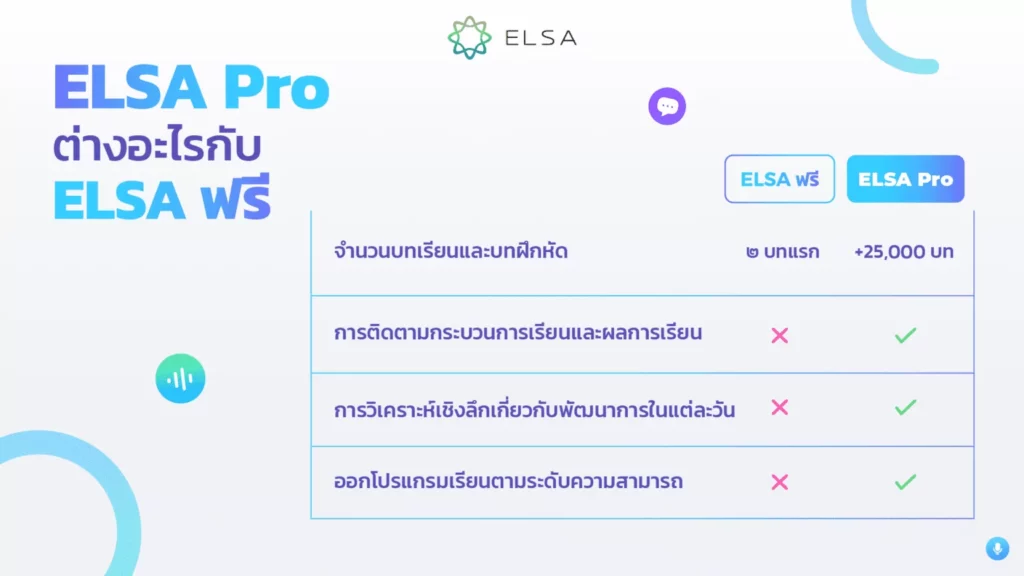
แบบฝึกหัดที่ 3: แต่ละประโยคด้านล่างมีข้อผิดพลาด 1 ข้อ โปรดค้นหาและแก้ไขให้ถูกต้อง
1. I think she will dancing when we get there.
2. Our parents will fly to London tomorrow.
3. That lazy worker won’t working when we arrive at the factory.
4. I think they still be writing that report at 3 this afternoon.
5. That active girl won’t be sit when we get to the event.
คำตอบ:
1. will dancing→ will be dancing
2. will fly → will be flying
3. won’t working → won’t be working
4. still be writing → will still be writing
5. won’t be sit → won’t be sitting
แบบฝึกหัดที่ 4: ผันคำกริยาในวงเล็บลงใน Future Continuous Tense หรือ Future Simple Tense ให้ถูกต้อง
1. This sofa is very comfortable. We__________________ (buy) it.
2. My sister__________________ (visit) her boyfriend’s family this weekend. She has planned this for months.
3. I don’t think that lazy employee__________________ (prepare) for the meeting when we get to the company.
4. It’s okay. I__________________ (will) clean that.
5. When I grow up__________________ (travel) around the world.
คำตอบ:
1. will buy (การตัดสินใจในขณะที่พูด)
2. will be visiting (แผนการในอนาคตอย่างแน่นอน)
3. will be preparing (คาดการณ์สิ่งที่จะเกิดขึ้นในช่วงเวลาหนึ่งในอนาคต)
4. will clean (การตัดสินใจในขณะที่พูด / สัญญา)
5. will travel (แผนการในอนาคตที่คลุมเครือไม่แน่นอน)
แบบฝึกหัดที่ 5: ผันคำกริยาในวงเล็บลงใน Future Continuous Tense หรือ Near Future Tense ให้ถูกต้อง
1. We__________________ (leave) HCM City tomorrow
2. My sister__________________ (visit) her boyfriend’s family this summer. (It’s still February.)
3. Look! Those dogs__________________ (catch) your cat.
4. Darcy and June__________________ (not go) camping tomorrow. They have canceled the plan.
5. We think that our daughter__________________ (do) homework when we get home tonight.
คำตอบ:
1. will be leaving (แผนงานที่ใกล้ปัจจุบันกว่า)
2. is going to visit (แผนงานที่ไกลปัจจุบันกว่า)
3. are going to catch (คาดการณ์สิ่งที่จะเกิดขึ้นในอนาคตได้อย่างมีพื้นฐาน)
4. won’t be going (แผนงานที่ใกล้ปัจจุบันกว่า)
5. will be doing (ทำนายสิ่งที่จะกำลังเกิดขึ้นในช่วงเวลาหนึ่งในอนาคต)
แบบฝึกหัดที่ 6: จับคู่แต่ละคำในคอลัมน์ A กับคำที่เหมาะสมในคอลัมน์ B
| A | B |
| 1. Sarah will be singing happily 2. I don’t think those active kids 3. They will be working, and we’ll be relaxing 4. I think they’ll still be cleaning the house at 3pm. 5. She won’t be cooking when we knock on her door. | A. at the beach at this time next Saturday. B. Our plan is to eat out. C. when we get to the karaoke bar. D. will be sitting still when we pick them up at the playground E. It’s very messy. |
คำตอบ:
1. C ─ 2. D ─ 3. A ─ 4. E ─ 5. B
แบบฝึกหัดที่ 7: ใช้ Future Continuous Tense เพื่อเติมประโยคด้านล่าง
1. At this time this weekend, my best friend and I…
2. My family and I… at 7:30 this evening.
3. I think my boss… at 10 tomorrow morning.
4. I… still…
5. When my boss enters the office tomorrow, I…
คำตอบ:
ประโยคเหล่านี้เป็นประโยคปลายเปิด ขึ้นอยู่กับความคิดของคุณเอง ดังนั้นคำตอบด้านล่างมีไว้สำหรับอ้างอิงเท่านั้น และเพื่อให้คุณเห็นวิธีการใช้ Future Continuous Tense
1. At this time this weekend, my best friend and I will be chatting at a coffee shop.
2. My family and I will be having dinner at 7:30 this evening.
3. I think my boss will be talking to a client at 10 tomorrow morning.
4. I will still be working at 9 tonight.
5. When my boss enters the office tomorrow, I will be typing a document.
หวังว่าบทความนี้จะช่วยให้คุณเข้าใจ และหลักการใช้งานในภาษาอังกฤษได้ดีขึ้น เมื่อนำไปใช้อย่างถูกต้อง Future Continuous Tense จะช่วยให้ประโยคมีความแม่นยำและสื่อความหมายได้อย่างชัดเจน ขอให้เรียนดีๆนะ!
1. when + อนุประโยค (clause) ก็ใช้ Present Simple Tense
2. (at) this time/ moment + ช่วงเวลาหนึ่งในอนาคต: (at) this time tomorrow, (at) this moment next weekend,…
3. at + ชั่วโมงที่เฉพาะ + ช่วงเวลาหนึ่งในอนาคต: at 7pm tomorrow, at 9:15 tomorrow morning,…


